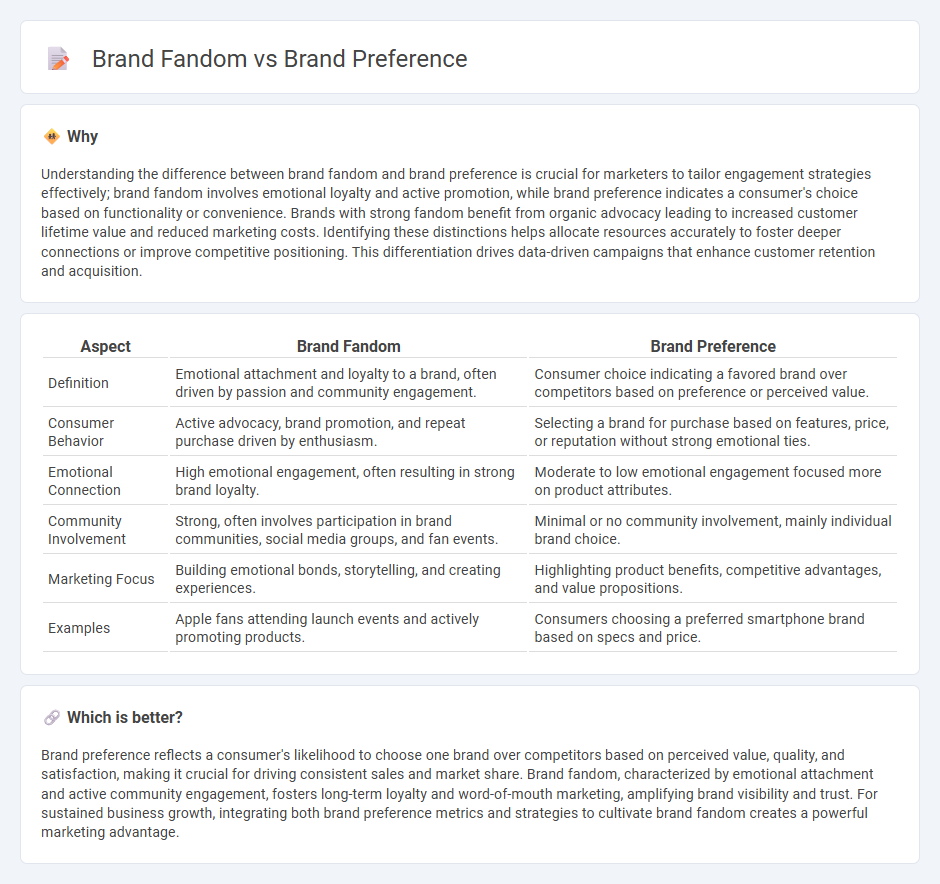
Brand fandom represents deep emotional loyalty where customers actively engage and advocate for a brand, while brand preference indicates a consumer's tendency to choose one brand over others based on perceived value or features. Fandom fosters strong community bonds and long-term retention, whereas preference often hinges on product attributes or price competitiveness. Explore how cultivating brand fandom can transform customer relationships beyond mere preference.
Why it is important
Understanding the difference between brand fandom and brand preference is crucial for marketers to tailor engagement strategies effectively; brand fandom involves emotional loyalty and active promotion, while brand preference indicates a consumer's choice based on functionality or convenience. Brands with strong fandom benefit from organic advocacy leading to increased customer lifetime value and reduced marketing costs. Identifying these distinctions helps allocate resources accurately to foster deeper connections or improve competitive positioning. This differentiation drives data-driven campaigns that enhance customer retention and acquisition.
Comparison Table
| Aspect | Brand Fandom | Brand Preference |
|---|---|---|
| Definition | Emotional attachment and loyalty to a brand, often driven by passion and community engagement. | Consumer choice indicating a favored brand over competitors based on preference or perceived value. |
| Consumer Behavior | Active advocacy, brand promotion, and repeat purchase driven by enthusiasm. | Selecting a brand for purchase based on features, price, or reputation without strong emotional ties. |
| Emotional Connection | High emotional engagement, often resulting in strong brand loyalty. | Moderate to low emotional engagement focused more on product attributes. |
| Community Involvement | Strong, often involves participation in brand communities, social media groups, and fan events. | Minimal or no community involvement, mainly individual brand choice. |
| Marketing Focus | Building emotional bonds, storytelling, and creating experiences. | Highlighting product benefits, competitive advantages, and value propositions. |
| Examples | Apple fans attending launch events and actively promoting products. | Consumers choosing a preferred smartphone brand based on specs and price. |
Which is better?
Brand preference reflects a consumer's likelihood to choose one brand over competitors based on perceived value, quality, and satisfaction, making it crucial for driving consistent sales and market share. Brand fandom, characterized by emotional attachment and active community engagement, fosters long-term loyalty and word-of-mouth marketing, amplifying brand visibility and trust. For sustained business growth, integrating both brand preference metrics and strategies to cultivate brand fandom creates a powerful marketing advantage.
Connection
Brand fandom intensifies emotional attachment, leading consumers to exhibit strong loyalty and advocacy behaviors. This heightened engagement drives consistent preference for the brand over competitors, influencing purchase decisions and long-term consumer retention. Understanding the psychological bond between brand fandom and preference helps marketers design targeted strategies to sustain consumer commitment and boost brand equity.
Key Terms
Customer Loyalty
Brand preference reflects a customer's inclination to choose one brand over others based on perceived value, quality, and past experiences, often driven by functional benefits and satisfaction. Brand fandom elevates this relationship by fostering emotional attachment, active engagement, and advocacy, transforming customers into passionate supporters who promote the brand within their communities. Explore deeper strategies to convert brand preference into enduring brand fandom and enhance customer loyalty.
Emotional Connection
Brand preference reflects a consumer's deliberate choice favoring one brand over others based on factors like quality, price, and trust. Brand fandom, however, signifies a deeper emotional connection, often characterized by loyalty, personal identity, and passionate advocacy for the brand. Explore how emotional engagement transforms customers into devoted brand fans by learning more about the psychology behind these connections.
Brand Advocacy
Brand preference reflects consumer choice tendencies toward a brand based on perceived value and satisfaction, whereas brand fandom embodies deeper emotional attachment and active engagement with the brand's community. Brand advocacy arises more prominently from brand fandom, where enthusiasts not only prefer but passionately endorse and promote the brand, driving organic growth through word-of-mouth and social influence. Explore how cultivating brand fandom can transform passive customers into powerful advocates who amplify your brand's reach and credibility.
Source and External Links
Brand preference - Wikipedia - Brand preference is the consumer tendency to favor a brand over others when price and availability are equal, driven by emotional, sensory, or social factors, and is a key indicator of brand strength and company performance measured by various methodologies including surveys and choice tests.
What Is Brand Preference? How To Win Over Customers - Shopify - Brand preference refers to customers repeatedly choosing your product over competitors', representing a crucial step toward brand loyalty and business success by being seen as the best solution for consumers' needs.
The Three Levels of Brand Loyalty and How to Achieve Them - Brand preference is the second level of brand loyalty where customers like a brand and may recommend it to others; building it involves satisfying customers, differentiating your brand, and implementing loyalty programs.
 dowidth.com
dowidth.com